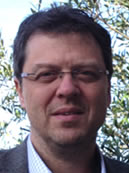 |
João F. Mano, João F. Mano is a Full Professor at the Chemistry Department of University of Aveiro, Portugal, and director of the COMPASS Research Group, formed in 2016 in the Associated Laboratory CICECO – Aveiro Institute of Materials. His research interests include the use of biomaterials and cells cells towards the progress of transdisciplinary concepts to be employed in regenerative and personalised medicine. In particular, he has been applying biomimetic and nano/micro-technology approaches to polymer-based biomaterials and surfaces in order to develop biomedical devices with improved structural and (multi-)functional properties, or in the engineering of microenvironments to control cell behaviour and organization, to be exploited clinically in advanced therapies or in drug screening. João F. Mano is author of 570+ papers in international journals (19000+ citations, h=69). He has been part of a series of scientific societies and editorial boards of international journals. He has been coordinating or involved in many national and European research projects, including an Advanced Grant from the European Research Council. |
João F. Mano
Department of Chemistry, CICECO — Aveiro Institute of Materials, University of Aveiro, 3810-193 Aveiro, Portugal
Abstract
Natural-based macromolecules have been used in the biomedical area, namely in supports for tissue engineering or in the controlled delivery of therapeutic molecules. They can be also combined with inorganic biomaterials, such as bioactive glass/ceramic nanoparticles, to improve their mechanical properties and be directed towards specific orthopaedic applications, as they can exhibit the ability to promote the deposition of bone-like apatite. In our research group different processing and modification strategies have been proposed to use such materials in different shapes (e.g. particles, fibres, membranes, scaffolds) or in the form of hydrogels. We have been using bio-inspired strategies to develop technologies to process new biomedical devices, such as with the use of superhydrophobic surfaces to fabricate hydrogel particles for a variety of applications in biomedicine. Moreover, the right spatial combination of cells and biomaterials could be used to recapitulate some organizations found in native tissues in order to develop better hybrid constructs for advanced therapies. Examples are shown on the development of liquefied capsules containing cells and solid microparticles that allow for a spatiotemporal free-organization of the cells towards the formation of new microtissues. More cases are shown where the combination of principles such as nanotechnologies, bottom-up tissue engineering and hierarchical organizations are used to obtain multi-functional structures to be used in regenerative medicine. free-organization in the space of the cells towards the formation of new microtissues.